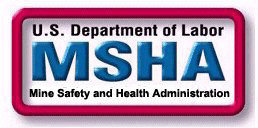
Mine Safety and Health Administration
Protecting Miners' Safety and Health Since 1978

 |
U.S. Department of Labor Mine Safety and Health Administration Protecting Miners' Safety and Health Since 1978 |
 |
| www.msha.gov |
|
|

Back injuries account for about one-fourth of the lost-time injuries in the mining industry. Many of these injuries could be avoided if miners practiced a few basic and simple rules for back conservation. The back is a complex system consisting of five distinct spinal regions. The lumbar spine, the five vertebrae and six disks in the curved portion of the lower back, is the part most often injured. Lifting, bending, and twisting motions (on or off the job) can cause severe injury and pain. Because the lumbar region is the back area at greatest risk during normal work, it deserves to be the main focus of back conservation and maintenance attention. LUMBAR CONSERVATIONTry to minimize the need to move materials manually. Proper planning and good job design can eliminate much lifting. The use of mechanical lifting aids can be a back-saver. However, if you must lift, remember that your body is not a crane; your back is not designed to "boom up", "boom down" or "boom to the side" with ease. Therefore, when lifting and carrying a load:Examine the load for grease, oil, sharp edges and other hazards. Know your limit and halve it; estimate the weight and divide the load or get help if the weight is more than you can comfortably handle. Plan your path and make sure that it is free of obstructions. Consider how you will set down the load-- before you lift it. Stand close to the load with your feet spread apart (at about shoulder width), with one foot in front of the other for balance. Do not twist your body to get into position. Squat down and tuck in your chin, while keeping your back as straight as possible. Grasp the load firmly. Lift with your legs by slowly straightening them. Return your back to a vertical position. Turn only with your feet; do not twist your torso while you are lifting or carrying a load. Avoid, if possible, lifting a load from below your knee level or from above your shoulder level; both maneuvers, unless done carefully, create great stress on the disks in the lumbar region. Carry the load close to your body. Avoid, if possible, any lift where the loads' center of gravity is more than a few inchesout from your belly; the stress on the lumbar region multiplies quickly as the center of gravity moves out from the spine. The squat down, lift with the legs maneuver does not come naturally to most miners and it is more tiring than the traditional bent-backlifting technique. Yet, its one great virtue--protection of the lumbar spine--makes it a maneuver well worth the extra effort. And remember the old refrain:"The human body is not a crane." While mucking (shovelling)--
LUMBAR MAINTENANCE Exercise your back regularly; back conditioning starts with body conditioning. The torso muscles are all interconnected; you must strengthen all of them to help your back. Concentrate on the exercises that strengthen each side equally, for example:low-impact aerobics, high-speed walking, rowing, and swimming. Machines that allow you to simulate rowing, stair-climbing or cross-country skiing at home are useful for back conditioning. Exercises that strengthen the lifting power of the legs can help the back by allowing the legs to do more of the heavy lifting. Be wary of activities with many sudden changes of directionor unnatural twisting, such as tennis and golf. Even runners may injure their backs, especially if they don't do enough stretching. Tobacco smoking diminishes the supply of oxygen and nutrients to the disks that cushion the vertebra. Thus, smokers are at increased risk of back trouble. Eliminate or at least diminish your use of tobacco; your back will be the better for it. And again, remember the old refrain:"The human body is not a crane." If you have any questions about this or any other occupational health matter, feel free to ask us. Our job is protecting your health. Contact:Mine Safety and Health Administration Metal and Nonmetal Health Division 1100 Wilson Boulevard Arlington, Virginia 22209-3939 Phone: (202) 693-9630 |
|
|
www.msha.gov | www.dol.gov |
|
| ||
|---|---|---|
|
| ||
|
Mine Safety and Health Administration (MSHA) 1100 Wilson Boulevard, 21st Floor Arlington, VA 22209-3939 |
Phone:
(202) 693-9400 Fax-on-demand: (202) 693-9401 Technical (web) questions: Webmaster On-line Filing Help: MSHAhelpdesk@dol.gov or call (877) 778-6055 Contact Us | |